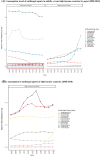Global Consumption Trend of Antifungal Agents in Humans From 2008 to 2018: Data From 65 Middle- and High-Income Countries
- PMID: 35960433
- PMCID: PMC9402496
- DOI: 10.1007/s40265-022-01751-x
Global Consumption Trend of Antifungal Agents in Humans From 2008 to 2018: Data From 65 Middle- and High-Income Countries
Abstract
Background: Understanding the trend of global antifungal agent consumption could assist with identification of global healthcare policy inadequacies and promote accessibility and availability of antifungal agents.
Methods: Using pharmaceutical sales data from the IQVIA-multinational integrated data analysis system database, we assessed use of systemic antifungal agents in humans in 27 middle- and 38 high-income countries from 2008 through 2018.
Results: Consumption of systemic antifungal agents increased from 0.50 (in 2008) to 0.92 defined daily dose (DDD)/1000 inhabitants/day (in 2018), with a compound annual growth rate of 6.2%. High-income countries remain major consumers of antifungal agents with large variance in quantities consumed, with a gradual decline in consumption in recent years. Consumption in middle-income countries increased. Itraconazole (0.32 DDD/1000 inhabitants/day), terbinafine (0.30 DDD/1000 inhabitants/day), and fluconazole (0.23 DDD/1000 inhabitants/day) were the most commonly used antifungal agents in middle- and high-income countries in 2018. Following incorporation into the World Health Organization Essential Medicines List, itraconazole consumption in middle-income countries surged. Consumption of ketoconazole slowly declined, with 5.04% annual decrease, probably due to labelling changes in 2013 to reflect hepatotoxicity concerns. The use of polyenes (0.004 DDD/1000 inhabitants/day) and echinocandins (0.003 DDD/1000 inhabitants/day) were lowest among all the antifungal drug classes.
Conclusion: Global consumption of triazoles and terbinafine has gradually increased in middle- and high-income countries. Life-saving antifungal agents, including echinocandins and polyenes, are available only parenterally and may be underutilized, mainly in middle-income countries. Future research on country-specific epidemiology is warranted to guide health policy coordination to ensure equitable access to appropriate use of antifungal agents.
© 2022. The Author(s).
Conflict of interest statement
EWC has received research grants from the Research Grants Council (RGC, Hong Kong), Narcotics Division of the Security Bureau of the Government of the Hong Kong SAR, Research Fund Secretariat of the Food and Health Bureau, National Natural Science Fund of China, Wellcome Trust, Bayer, Bristol-Myers Squibb, Pfizer, Janssen, Amgen, and Takeda, outside the submitted work. ICKW has received research grants from Research Grants Council (RGC, Hong Kong), Innovative Medicines Initiative (IMI), Shire, Janssen-Cilag, Eli-Lily, Pfizer, Bayer, and grants from European Union FP7 program, outside the submitted work. DCMK has sat on advisory boards for Becton Dickinson Pty Ltd and Merck Sharp & Dohme (MSD), and received financial support from MSD and F2G, outside the submitted work. MS has received grants from Gilead Sciences, Merck, F2G, and Pfizer unrelated to the submitted work. BJC has received funding from Sanofi Pasteur and Roche, outside the submitted work. The other author(s) declare no conflict of interest.
Figures







Similar articles
-
Psychotropic medicine consumption in 65 countries and regions, 2008-19: a longitudinal study.Lancet Psychiatry. 2021 Dec;8(12):1071-1082. doi: 10.1016/S2215-0366(21)00292-3. Lancet Psychiatry. 2021. PMID: 34801129 Free PMC article.
-
European Surveillance of Antimicrobial Consumption (ESAC): outpatient systemic antimycotic and antifungal use in Europe.J Antimicrob Chemother. 2010 Apr;65(4):769-74. doi: 10.1093/jac/dkq023. Epub 2010 Feb 8. J Antimicrob Chemother. 2010. PMID: 20142264
-
Gabapentinoid consumption in 65 countries and regions from 2008 to 2018: a longitudinal trend study.Nat Commun. 2023 Aug 17;14(1):5005. doi: 10.1038/s41467-023-40637-8. Nat Commun. 2023. PMID: 37591833 Free PMC article.
-
New antifungal agents.Eur J Clin Microbiol Infect Dis. 1989 May;8(5):402-12. doi: 10.1007/BF01964056. Eur J Clin Microbiol Infect Dis. 1989. PMID: 2546775 Review.
-
Antifungal agents.Med J Aust. 2007 Oct 1;187(7):404-9. doi: 10.5694/j.1326-5377.2007.tb01313.x. Med J Aust. 2007. PMID: 17908006 Review.
Cited by
-
Trend analysis and cross nations inequality analysis of infectious skin diseases from 1990 to 2021.Arch Dermatol Res. 2025 Jan 8;317(1):203. doi: 10.1007/s00403-024-03757-9. Arch Dermatol Res. 2025. PMID: 39775948
-
Vertical Transmission and Antifungal Susceptibility Profile of Yeast Isolates from the Oral Cavity, Gut, and Breastmilk of Mother-Child Pairs in Early Life.Int J Mol Sci. 2023 Jan 11;24(2):1449. doi: 10.3390/ijms24021449. Int J Mol Sci. 2023. PMID: 36674962 Free PMC article.
-
Worldwide emergence of fluconazole-resistant Candida parapsilosis: current framework and future research roadmap.Lancet Microbe. 2023 Jun;4(6):e470-e480. doi: 10.1016/S2666-5247(23)00067-8. Epub 2023 Apr 27. Lancet Microbe. 2023. PMID: 37121240 Free PMC article. Review.
-
Azole Antifungal Consumption in Community Pharmacy Sales in Mainland Portugal: Trend Analysis from 2014 to 2023.Antibiotics (Basel). 2025 Jan 4;14(1):33. doi: 10.3390/antibiotics14010033. Antibiotics (Basel). 2025. PMID: 39858319 Free PMC article.
-
The Impact of Antifungal Stewardship on Clinical and Performance Measures: A Global Systematic Review.Trop Med Infect Dis. 2023 Dec 29;9(1):8. doi: 10.3390/tropicalmed9010008. Trop Med Infect Dis. 2023. PMID: 38251205 Free PMC article. Review.
References
-
- Global Action Fund for Fungal Infections. 95–95 by 2025. Improving outcomes for patients with fungal infections across the world: a roadmap for the next decade. 2020. https://www.gaffi.org/. Accessed 19 Feb 2020.
-
- World Health Organization. WHO model list of essential medicine, 21st list. 2019. https://www.who.int/medicines/publications/essentialmedicines/en/. Accessed 17 Aug 2020.
-
- Hsia Y, Sharland M, Jackson C, Wong ICK, Magrini N, Bielicki JA. Consumption of oral antibiotic formulations for young children according to the WHO Access, Watch, Reserve (AWaRe) antibiotic groups: an analysis of sales data from 70 middle-income and high-income countries. Lancet Infect Dis. 2019;19(1):67–75. doi: 10.1016/S1473-3099(18)30547-4. - DOI - PubMed
MeSH terms
Substances
LinkOut - more resources
Full Text Sources
Research Materials

